When the 3 Daily Scrum Questions Stop Working — and What to Ask Instead
Discover modern Scrum standup questions that go beyond daily status updates to improve collaboration, focus on sprint goals, and drive real team value.
The Daily Scrum is a vital Agile project management ritual. It aligns teams, surfaces blockers, and keeps projects on track. For years, teams have relied on three questions to guide these stand-ups:
- What did you do yesterday?
- What will you do today?
- Are there any impediments in your way?
These Scrum standup questions once brought clarity and focus. They helped teams coordinate and communicate effectively in early Agile adoption. But in mature teams, they often feel repetitive, turning collaboration into a status report. As teams gain expertise, their needs evolve. They crave discussions about outcomes, risks, and innovation. This article explores why the classic questions falter, how to spot a struggling Scrum, and what to ask instead to make stand-ups strategic and engaging.
Why the Classic Scrum Standup Questions Fall Short
The three-question format is simple but limiting for seasoned teams. Below, we explore why they fail, using concise explanations and strategic bullet points to highlight key issues.
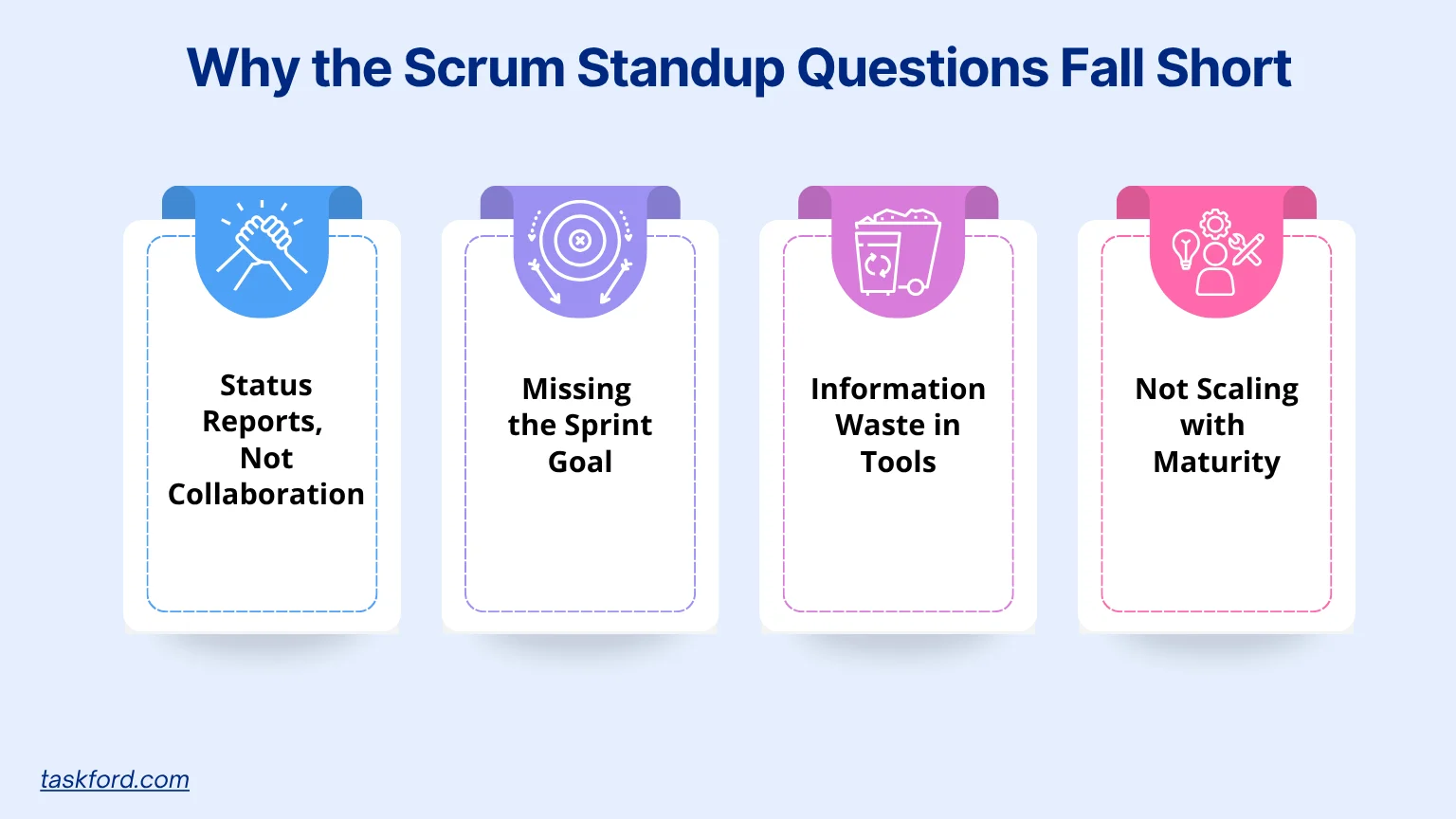
1. Status Reports, Not Collaboration
The traditional questions turn the Daily Scrum into a status meeting. Team members report to the Scrum Master or Product Owner, not each other, creating a top-down vibe. This clashes with Agile’s self-managing ethos, stifling team dialogue.
- Updates lack peer engagement: Developers give updates like, “I finished task #123 and will start #124.” These are directed at the supervisor, not teammates. This limits chances for peers to offer insights or suggest pairing.
- Collaboration opportunities are missed: A developer might not mention a dependency another teammate could resolve. This stalls progress and reduces the Scrum’s value. The meeting should spark team problem-solving, not just inform one person.
The Scrum needs to foster interaction, not just reporting.
2. Missing the Sprint Goals
The questions focus on tasks, not the sprint goals. This disconnects daily work from the team’s shared objective. Updates become a list of activities, not steps toward outcomes.
- Tasks overshadow outcomes: A developer might say, “I updated the database schema,” without linking it to the goal, like a faster customer dashboard. This risks misaligned priorities, as tickets get done but the goal stalls. The Scrum should tie every update to the broader objective.
- Focus drifts to tickets: A team building a checkout feature might discuss CSS tweaks instead of user flow improvements. This dilutes the meeting’s strategic impact. Aligning updates with the goal keeps the team on track.
The Scrum must center on outcomes to drive progress.
3. Information Waste in Tools
Many teams rely on digital boards for real-time tracking. Stating “I’m on ticket #45” adds little value if the Kanban board already shows this. The Scrum should uncover unique insights, like risks or collaboration needs, to stay relevant.
4. Not Scaling with Maturity
Novice teams need the three questions for structure. Mature teams, however, want deeper discussions. The rigid format holds them back from tackling complex issues.
- Experienced teams need more: Senior teams report tasks like “I wrote code for feature X” instead of discussing risks or dependencies. For a micro services project, they might need to address API latency, not just code commits. The Scrum should support strategic conversations for advanced teams.
- Structure limits innovation: The three questions feel restrictive when teams face complex challenges, like integration bottlenecks. Mature teams want to discuss process improvements or delivery risks. Evolving questions unlocks their potential.
Questions must match the team’s expertise to stay effective.
When Your Scrum Standup Questions Stop Delivering Value
Is your Daily Scrum faltering? Here are clear signs it’s time to rethink your Scrum standup questions, with concise explanations and targeted bullet points.
1. It’s Just a Status Update
The Scrum feels like a report to the Scrum Master. Developers list tasks without engaging peers. This kills the collaborative spirit Agile project management requires.
- Updates lack interaction: A developer says, “I’m debugging issue #12,” with no follow-up discussion. This turns the facilitator into a note-taker, not a collaborator. The meeting should spark teammate input to solve problems.
- Hierarchy creeps in: The Scrum Master becomes a “manager,” against Agile’s self-management principle. Team members stop sharing ideas or offering help. This reduces the Scrum’s value as a team-driven space.
Encourage dialogue to restore collaboration.
2. Sprint Goal Gets Ignored
Updates focus on tickets, not outcomes. The team loses sight of the sprint goal. This misaligns priorities and weakens impact.
For example, if the goal is a new checkout feature, discussing “fixing a button’s CSS” misses the mark. Tasks get done, but the goal stalls. The Scrum should reinforce the goal daily to keep efforts aligned.
3. Engagement Drops Off
Team members see the Scrum as a chore. They multitask, skip meetings, or give vague updates like “Same as yesterday.” This shows the meeting lacks value.
- Disengagement signals trouble: Developers check phones or rush through updates. This happens when the Scrum feels like an interruption, not a tool. Engagement fades without actionable outcomes.
- Low value hurts morale: A pointless meeting frustrates the team. Developers stop attending or contribute minimally. The Scrum needs to drive progress to keep everyone invested.
Make the Scrum a tool for action, not routine.
4. Blockers Linger Unresolved
Blockers surface daily but don’t get fixed. The Scrum fails to drive action. This stalls progress and frustrates the team.
- Issues repeat without solutions: A developer flags delayed specs repeatedly, but no one acts. Agile requires adaptation, but unresolved blockers block flow. The Scrum should spark solutions, not just highlight problems.
- Action is missing: A code review delay might be noted but not addressed. The team misses chances to assign reviewers or clarify needs. This stagnation shows the meeting isn’t working.
Use the Scrum to resolve issues, not just report them.
Key Insight: A Scrum should drive action after the meeting. If it’s just talk, it’s time for new questions.
What to Ask Instead: Scrum Standup Questions That Drive Value
Replace the three questions with alternatives that focus on outcomes, collaboration, and improvement. Here are four categories of Scrum standup questions with guidance.
1. Goal-Oriented Questions
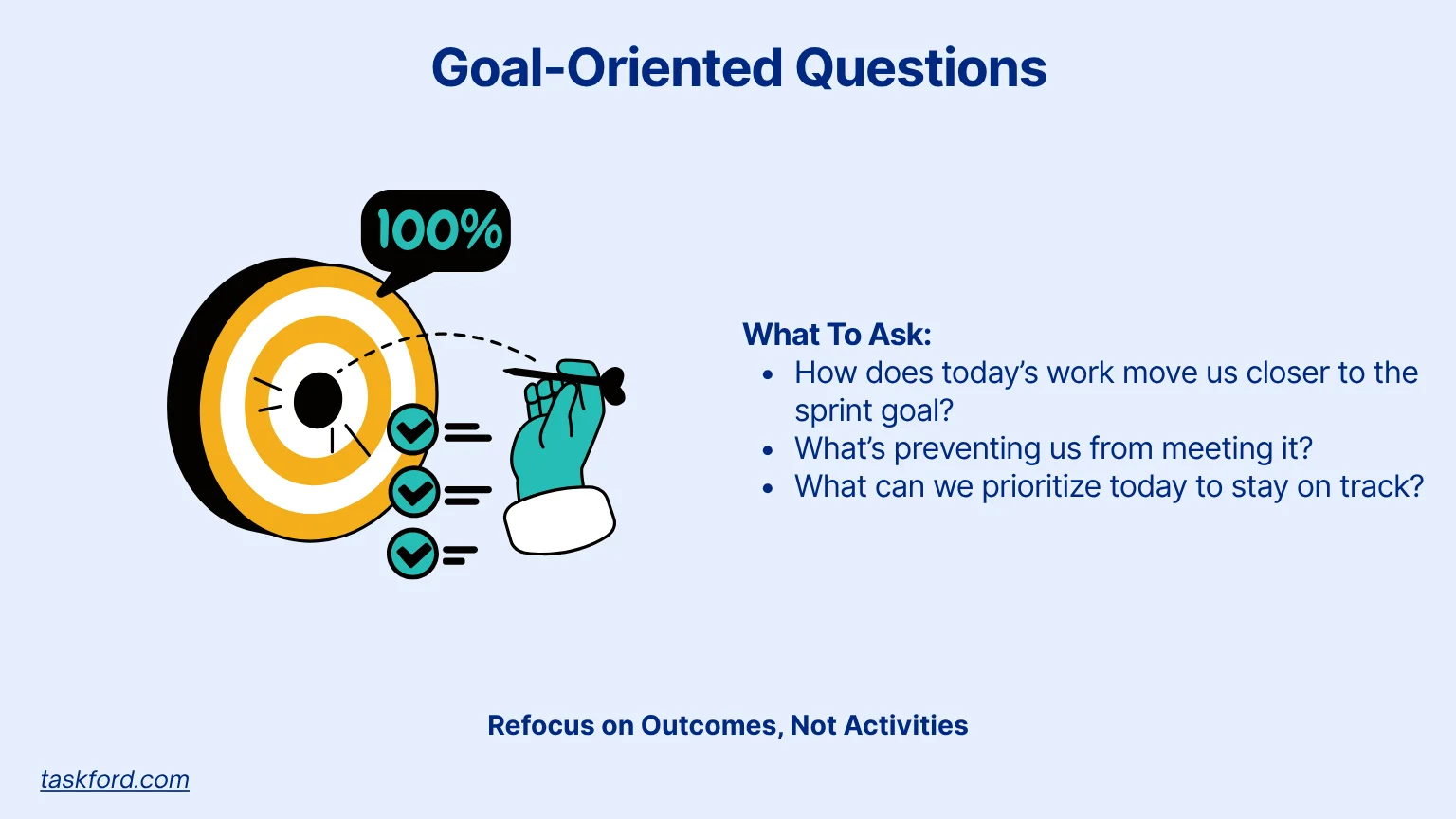
- How does your work today move us closer to our sprint goal?
- What’s preventing us from meeting it?
- What can we prioritize today to stay on track?
When to use: For teams losing sight of outcomes. A developer might say, “I’m optimizing the query algorithm to speed up searches, supporting our user experience goal.”
2. Collaboration-Focused Questions
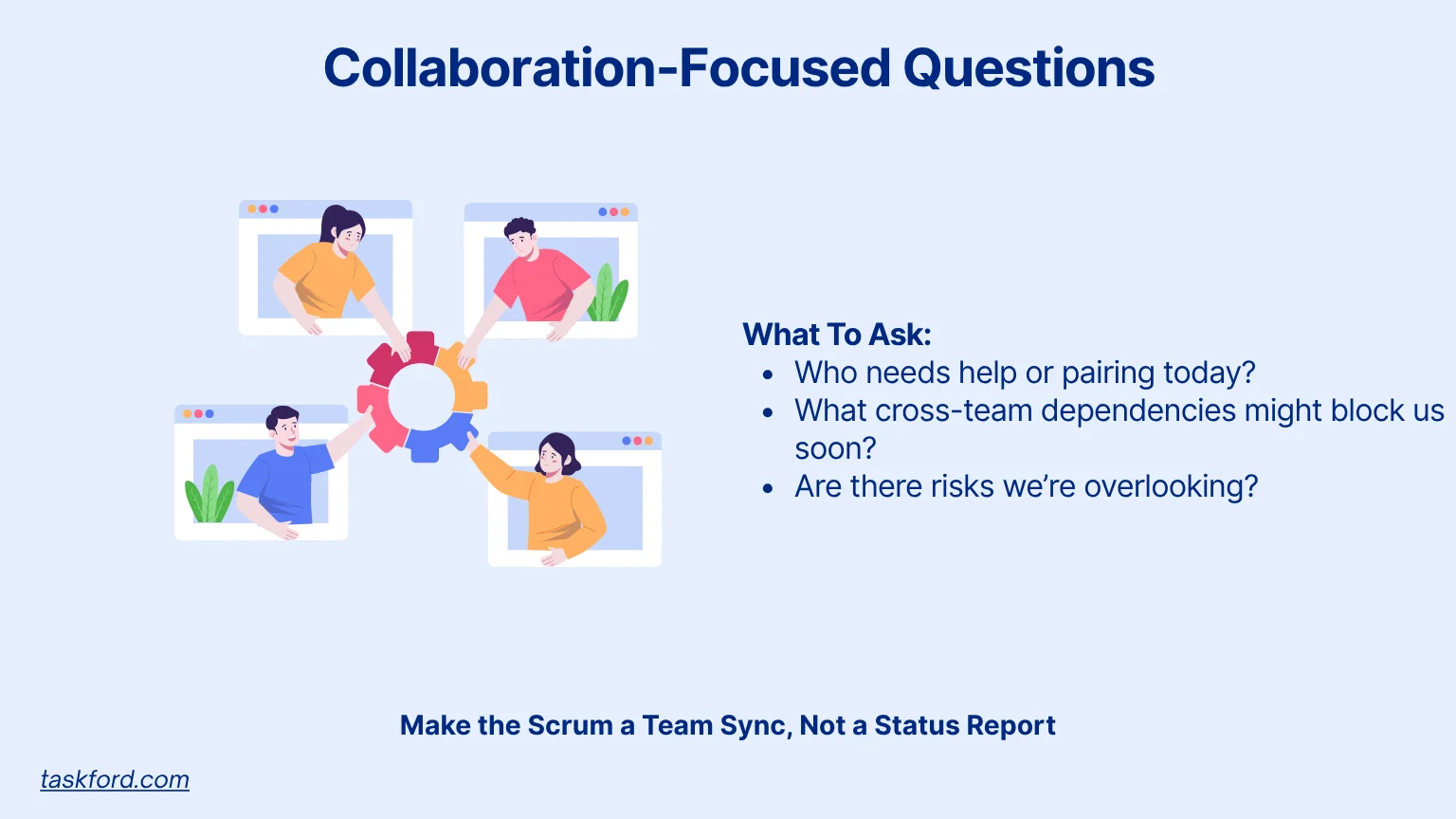
- Who needs help or pairing today?
- What cross-team dependencies might block us soon?
- Are there risks we’re overlooking?
When to use: For complex projects with many stakeholders. Example: “I need to sync with UX on the form design to unblock our prototype.”
3. Improvement-Oriented Questions
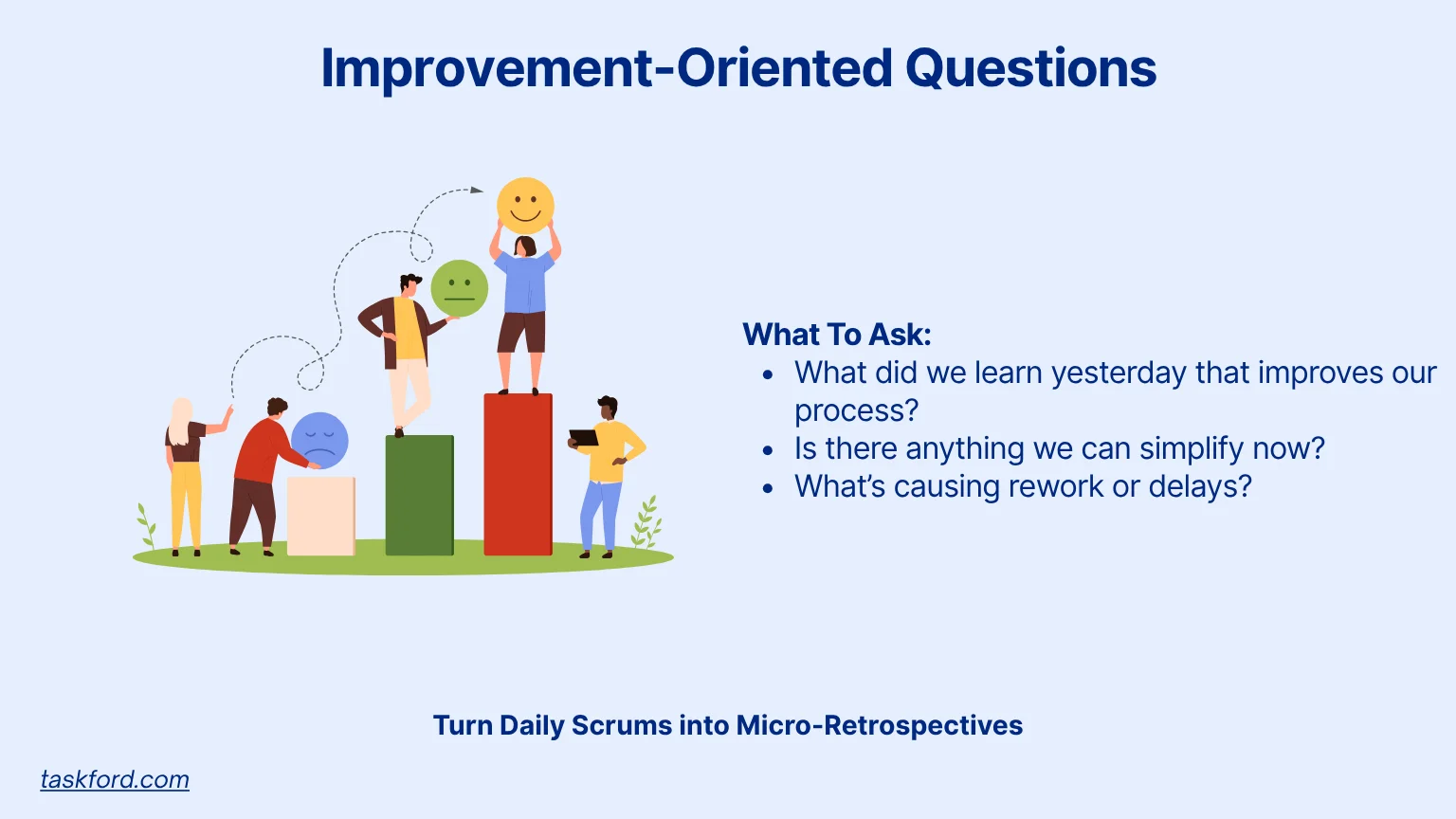
- What did we learn yesterday that can improve our process?
- Is there anything we can simplify now?
- What’s causing rework or delays?
When to use: For teams with inefficiencies like repetitive bugs. Example: “We’re retesting due to unclear specs; can we clarify them today?”
4. Context-Aware Questions
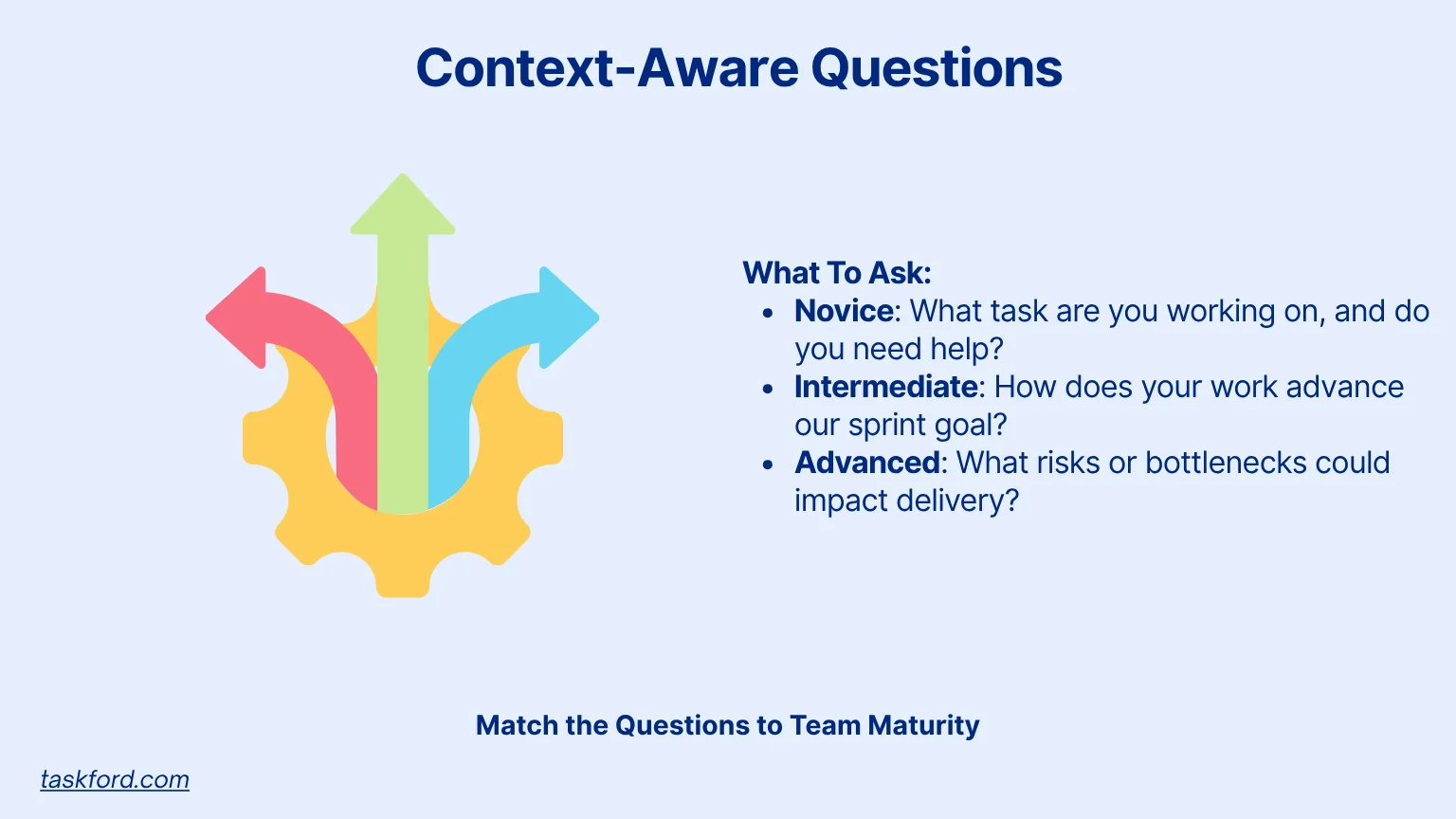
- Novice teams: What task are you working on, and do you need help?
- Intermediate teams: How does your work advance our sprint goal?
- Advanced teams: What risks or bottlenecks could impact delivery?
When to use: Match to team maturity. A mature team might say, “API latency could miss our deadline; let’s discuss load testing.”
Advanced Tips for Modern Stand-ups
New questions need strong support. Here are tips to make your Scrum dynamic, with clear guidance.
1. Anchor to the Sprint Goal
Start by restating the sprint goal on a Kanban board. For a team improving a mobile app, say, “Our goal is faster load times; let’s focus there.” This aligns updates with outcomes. It keeps the team focused and makes the Scrum purposeful.
2. Rotate the Facilitator
Let team members lead the Scrum to build ownership. A developer might ask, “Can anyone help with this blocker?” This avoids hierarchy and boosts engagement. Train facilitators to ask follow-ups like, “How does that affect our timeline?”
3. Use Flow Metrics as Triggers
Use visuals like cycle time charts to spot issues. If tasks pile in “Testing,” ask, “What’s causing this bottleneck?” This makes problems clear and sparks solutions. It turns the Scrum into a problem-solving hub.
4. Leverage Tools, Don’t Serve Them
Tools like TaskFord are aids, not the focus. Encourage talk about risks or trade-offs. Example: “I’m on ticket #67, but API scalability worries me; can we discuss?” This ensures the Scrum adds value beyond tools.
Case Study: Transforming Scrum Standup Questions into Strategic Alignment
A 12-person fintech Scrum team had dull stand-ups. Developers listed tasks like “I worked on ticket #89,” while blockers like delayed API specs lingered. Engagement was low, and 40% of sprint goals were missed.
They adopted new questions:
- How does today’s work move us toward the sprint goal?
- What risks or dependencies should we tackle?
- What can we improve today?
They showed their sprint goal, a payment feature, on a Kanban board and rotated facilitators. In three sprints, meetings dropped to 12 minutes, blockers cleared faster, and goal completion hit 85%. The team felt energized, as stand-ups became problem-solving sessions.
Measuring the Impact of Improved Scrum Standup Questions
A revitalized Scrum shows clear wins for project management. Here are signs it’s working:
- Shorter, Focused Meetings: Stand-ups last 10-15 minutes and feel purposeful. Updates spark action, like fixing a blocker, keeping things efficient. This respects the team’s time while driving progress.
- Fewer Recurring Blockers: Issues get resolved quickly, not repeated. A delayed review gets a reviewer assigned in the Scrum. This shows the meeting drives solutions.
- Improved Sprint Outcomes: The team hits sprint goals regularly, delivering a valuable increment. Focusing on outcomes aligns tasks to the big picture. This ensures delivery as planned.
- Better Team Sentiment: Team members see the Scrum as a tool, not a chore. They engage, ask questions, and offer help. This boosts morale and ownership.
Pro tip: Ask in a retrospective, “How do our stand-ups help us deliver?” to refine further.
Conclusion: Evolving Scrum with Your Team
Scrum is a framework, not a checklist. When the three Scrum standup questions stop working, your team is evolving. Use goal-oriented, collaboration-focused, and improvement-driven questions to make stand-ups strategic. Tailor them to your team’s maturity, use visuals and rotating facilitators, and keep the sprint goal central. When the Scrum grows with your team, it drives Agile success, not just routine.
Learn more
- Scrum vs Sprint: Why the Debate Exists and What Teams Really Need to Understand
- What is Project Management? The Complete First Guide for Newbies
- Agile Project Management vs Waterfall - What's The Difference?
Making work simpler,
smarter, and more connected
Join our waitlist and be notified first.

Related Blog
Subscribe for Expert Tips
Unlock expert insights and stay ahead with TaskFord. Sign up now to receive valuable tips, strategies, and updates directly in your inbox.






